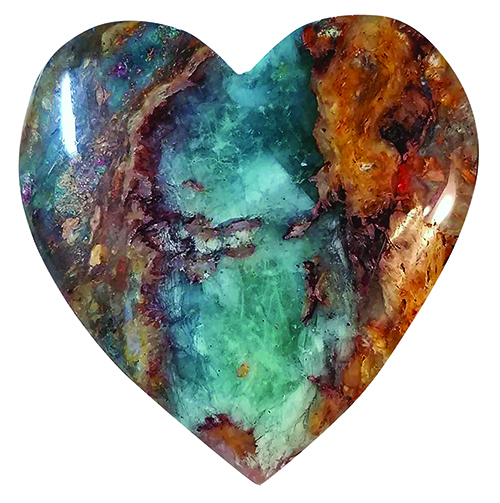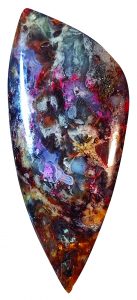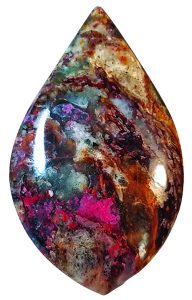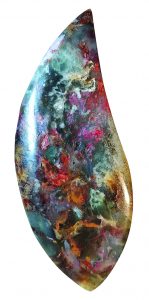
By Russ Kaniuth
Clear Creek Plasma agate is one of those very unique materials found only in San Benito County, California, between Hollister and Coalinga in the Clear Creek Recreation Area, BLM Land.
This area was closed for many years due to asbestos hazards but now open once again, although only by permit. Anyone can obtain a permit online, but each person is allowed only a certain amount each year. Clear Creek is also home to hundreds of minerals, including the California State gemstone, benitoite.
Rockhounding in this area is a wonderful experience. There are two campsites at the entrance of the park, and there are miles of land open to collecting.
Unique Composition
 Clear Creek Plasma agate is unique due to all the properties incorporated within. It’s composed of chalcedony, serpentine, jade or jadeite, chromite, cinnabar, and various other minerals, which gives way to an array of colors.
Clear Creek Plasma agate is unique due to all the properties incorporated within. It’s composed of chalcedony, serpentine, jade or jadeite, chromite, cinnabar, and various other minerals, which gives way to an array of colors.
The bright greens and reds certainly stand out and make this material well sought after for lapidary use.
If you can experience collecting this material on your own, the trip is well worth it, however, if you must buy from a source, keep a few things in mind. When buying rough, it is very difficult to gauge how much usable material you will get from each piece of rock, as there are many porous areas throughout this material, so there could be a great deal of waste. However, this doesn’t mean you won’t get a substantial amount of good area in each slab to make cabs, just something for which to be aware.
Angle Angle Yields Similar Pattern
Slabbing this material is relatively easy because there is no correct direction in which to cut. Any angle will yield the same type of patterns, so it’s just best that you find an angle that fits the vice of your saw so it will tighten securely. Once your slabs are cut, examine your material, and wet it lightly with a damp cloth, and watch it dry. Since there are so many minerals involved with this material, not all slabs will cab evenly.
The softer areas tend to undercut, so by wetting the slab and watching it dry, the softer, more porous areas, which tend to soak up the water and dry first, will reveal the more solid agate areas. Having this knowledge will be much more favorable for cabbing.
Once you have your slabs marked and ready to trim out for cabs, you should always wear protective gear when trimming and cabbing this material, due to asbestos and cinnabar inclusions. Even though many people may believe running water on their cabbing machines will knock all the dust down, the truth is, the mist coming up from the machines still contain microparticles that could be ingested, so it’s always best to wear a respirator mask, as well as eye protection.
Enjoy the Cabbing Process
Cabbing this material is quite simple and enjoyable. Just like any other hard jasper or agate, start on the 80-grit wheel to shape and dome the cabs, then move to a 220 grit to smooth it out further. At this point, stop and dry the cabochon thoroughly to check for any pits or soft areas that will undercut.
other hard jasper or agate, start on the 80-grit wheel to shape and dome the cabs, then move to a 220 grit to smooth it out further. At this point, stop and dry the cabochon thoroughly to check for any pits or soft areas that will undercut.
Many people like to fill in the pits to have a continuous gloss finish across the top of the cabs, while others leave it natural. If you want to fill in the low spots or pits, this point in the process would be the time to do so before moving forward.
The rest of the cabbing process with this form of agate is very routine. Just continue through the rest of the grits, until reaching the 14k or 50k grit wheel, at which point a beautiful high gloss finish will be present on the Clear Creek Plasma agate cabochon.
















